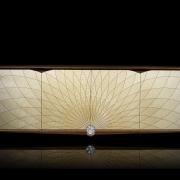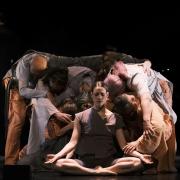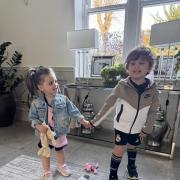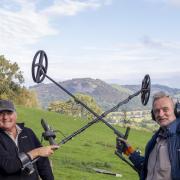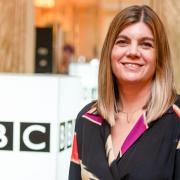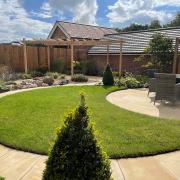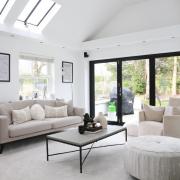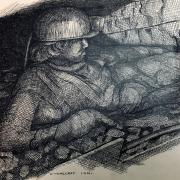When John Dison founded Frodsham-based Earthborn Paints in 2002, he was somewhat ahead of the eco-conscious curve, but his passion proved prophetic
In 2002, which seems not so long ago, but is more than two decades past (much to my surprise) our awareness of ‘doing our bit’ for the environment wasn’t nearly as widespread as it is today. Recycling was something other people did, organic food was an expensive luxury and plastics were barely considered, much less reviled – the plastic bag charge only came into force as recently as 2015. So when a chap with a background in town planning decided to launch a paint company (not an easy feat in itself) and make that paint as absolutely earth, air and living being-friendly as it could be, he most certainly set himself a challenge.

“John’s background was town planning,” Cathryn Sanders, commercial manager for Earthborn Paints, explains. “The synergy comes from his realisation that everything we use in our buildings, where we live and where we work, we really need to start thinking about it all, about the materials we use, not just in terms of sustainability, but in terms of our health, and that of the building.’
You may have heard of ‘sick building syndrome’, first identified in the 1970s and the term applied to a situation in which some or all the people occupying a building (working or living in it) experience symptoms such as headaches, nausea, itchy eyes, nose, or throat, a dry cough or skin irritation, all of which stop when you’re not in the ‘sick’ building. It’s often put down to poor air quality due to inadequate ventilation, but also to chemical contaminants in the air from VOCs (solvents in paint that leach into the atmosphere) and possibly moulds and bacterias growing within. This awareness of how our manmade environment can so negatively impact our health is what has driven so many eco-businesses, although sadly they are often still sitting on the fringes, while the big brands take much smaller steps to make it right.

“It was quite revolutionary at the time,” Cathryn adds. “People, when they thought of ‘eco paint’ would have thought more of lime washes, so it was quite a laborious task to use an eco-paint then, but John was really keen to get people really understanding they should be considering all elements of their building, but not in too forceful a way, just in that moment when considering your décor, if you could add the eco element into that it would be a good thing for the environment and their health.
“At the time it was definitely ahead of the curve, and was quite a task to get the message across that the paints wouldn’t be wishy washy, but rich and opaque and beautiful to work with. It took a bit of time, but our range is beautiful and people did start to see the benefits and the beauty,” Cathryn says.
John has retired from the business now, though, as Cathryn says “he’s never going to really retire,” but his business still operates according to its founding principles.
“There’s nothing in our paints you wouldn’t want to put on a child’s toy. We would never claim there are no VOCs in our paint, because organic compounds occur naturally in clay, but there’s nothing added you could call a nasty.”
The brand’s hero product is their Claypaint. This is exactly what it says on the tin (where every single ingredient is listed): a water-based paint totally free from oils and acrylics and with, you guessed it, a very high clay content, which gives it a creamy, rich consistency and a totally matt finish.
“Claypaint has a larger percentage of clay than our other paints; the benefit of that is it gives a very flat matt finish. It’s got high breathability so it’s comparable to a limewash, for example, so allows your walls to breathe, but in essence it’s an emulsion paint, very easy to use and giving a rich, lush colour,”Cathryn explains.

“Our Lifestyle paint was developed for use in areas where something more hardwearing was required; up the side of the stairs, or maybe in the kitchen. Then we also have Eggshell No. 17 for woodwork, and we also introduced Eco Chic, a clay-based paint designed for painting furniture. This was a recent addition to the collection by demand of our stockists, who were seeing many more people looking for the right paint for their upcycling projects.”
Now, to the important stuff – how do Earthborn choose their colour palette, and really importantly, how do they choose the names for each shade? With names ranging from Bobble Hat to Maybe Maggie, it sounds like this can be fun.
“It is,” Cathryn laughs, “and possibly my favourite part of my job. When Earthborn launched we had a limited colour range, all colours that derived naturally from clay itself, and we still have a few of these, perennial top sellers, on our colour chart, such as our Marbles and Humpty Dumpty. As the business grew we added more and more and now have 72 colours in our Claypaint range, which feels like the right number of colours running from the neutrals to the richer shades, without it being too overwhelming for the customer. Because they all have the same clay base, all the colours work in harmony with each other, creating a tonal consistency.

“Every couple of years we give the collection a refresh, based on trends coming through or to fill a gap, and we’re actually going to be doing that next year. The neutral colours are always popular, but lately we’re seeing customers show some greater confidence with colour, which is why we have those deeper shades in the collection and will be looking at these soon.
“We have an annual Colour of the Year and for 2023 this has been Lady Bug, a beautiful richly-toned red, an increasingly popular trend is people looking to nature for inspiration, bringing the outdoors in, and this colour really has that cocooning effect. Reds can be bold, but can also wrap you up and cocoon you, and we’re seeing more people see bold colours as comforting, not challenging.”
All new colour development is done in-house at Earthborn.
“We’re not a large team, so everybody can have an opinion,” Cathryn says. “We start with looking for gaps, at trends, feedback from our stockists and then start to play with mixes. It’s such a fun time; the hardest thing is to restrict ourselves to only adding a limited number of paints – and which ones do you then take off?

“And then, yes, once we’ve decided on the colours, we have a lot of fun deciding on their names. We try not to be too literal, but take inspiration from our surroundings, things we love, the people in our lives... Hobby Wood for example takes inspiration from Hob Hey Wood, which is close by our offices, and Lily Lily Rose from a painting of the same name by John Singer Sergent where a young girl is wearing a dress in a similar shade.
“We try to have a bit of fun with it; there’s a reason for every name, but it can be a bit loose. Everyone who works here likes to throw in ideas, they all go in the book. Anybody who has been here a while definitely has a name that has made it onto the colour card; it can get quite competitive, but the final decision stops with me.”





